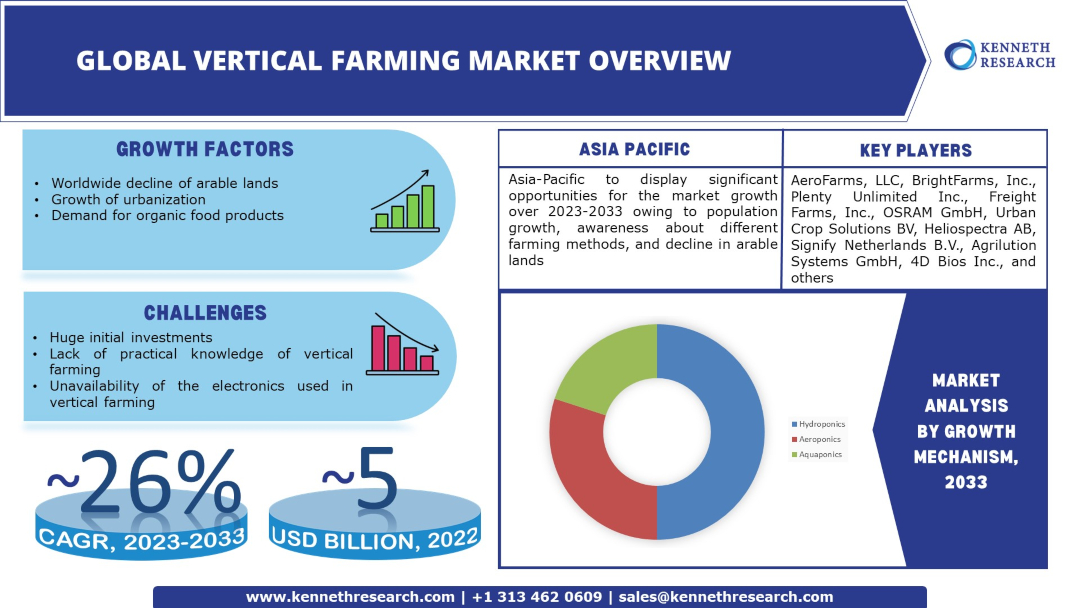Vertical Farming Market Analysis by Growth Mechanism (Hydroponics, Aeroponics, and Aquaponics); by Structure (Building-based Vertical Farms, and Ship Container Vertical Farms); and by Component (Lighting System, Irrigation and Fertigation System, Climate Control, Sensors, and Others)-Global Supply & Demand Analysis & Opportunity Outlook 2023-2033
-
Product Code:
RP-ID-10352485 -
Published Date:
31 Oct 2022 -
Region:
Global
-
Category:
Semiconductor & Electronics -
Publisher:
Pub-ID-54
Impact Analysis on the Growth of Market
Inflation and Looming Recession to Haunt Businesses:
In 2022 & 2023, market players expected to sail in rough waters; might incur losses due to huge gap in currency translation followed by contracting revenues, shrinking profit margins & cost pressure on logistics and supply chain. Further, U.S. economy is expected to grow merely by 3% in 2022.
....
The Research Report is Updated with 2022 Base Year, 2023 Estimated year and Forecast till 2035 with Market Insights.
With the dip in global production, the GDP has contracted in 2020 and impacted the market across the world. Upon placing a Sample Request, you will receive an updated report with 2022 as base year, 2023 as estimated year and forecast to 2035. This will have market drivers, recovery rate in the market, insights and competitive analysis.
Market Overview:
Translate Report
Global Vertical Farming Market Scope Report
|
Base Year |
2022 |
|
Forecast Year |
2023-2033 |
|
CAGR |
~26% |
|
Base Year Market Size (2022) |
~ USD 5 Billion |
|
Forecast Year Market Size (2033) |
~ USD 34 Billion |
Global Vertical Farming Market Size, Forecast, and Trend Highlights Over 2023 - 2033
The global vertical farming market is estimated to garner a revenue of ~USD 34 billion by the end of 2033 by growing at a CAGR of ~26% over the forecast period, i.e., 2023 – 2033. Further, the market generated a revenue of ~USD 5 billion in the year 2022. The considerable decline in arable land in many parts of the world is the primary factor driving the growth of the global vertical farming market. For instance, it was observed that the total arable land in China in 2019 was about 7% less compared to the total amount just a decade before.

GET A SAMPLE COPY OF THIS REPORT
Several factors cause the decline of arable lands, including population growth, land degradation, climate change, deforestation, urban sprawl, and more. Vertical farms conserve both land and operating room by using space vertically with layers of crops stacked one on the other.
Global Vertical Farming Market: Growth Drivers and Challenges
Growth Drivers
-
Rapid Growth of Urbanization – It is estimated that the total urban population in the world should surpass 5 billion by 2045. Industrialization, social benefits and services, commercialization, employment opportunities, change in the mode of living, and modernization are the main factors leading to the growth of urbanization. Most of the vertical farms are established in and around urban areas, with the urban population constituting the primary consumers of the farm produce. This localization of farms also minimizes transportation needs and thus greenhouse gas (GHG) emissions.
-
High Demand for Organic Food Produces – In 2020, up to 5% of the total food sales in the United States (U.S.) was comprised of sales of organic food.
-
Rapid Increase in the Number of Health-Conscious Customers – As of 2022, between 24 and 31% of all grocery customers in the U.S. and Europe should be categorized as health-conscious customers.
-
Rapid Growth in Agricultural Waste – The annual amount of agricultural waste produced in Russia is estimated to reach up to 651 million tons.
Challenges
-
Requirement for Large Initial Investments
-
Lack of Practical Knowledge of Farming Methods Among Farmers
-
Delay in the Manufacturing and Supply of Electronics Needed in Vertical Farming as a Result of COVID-19
The global vertical farming market is segmented and analyzed for demand and supply by growth mechanism into hydroponics, aeroponics, and aquaponics. Of these, the hydroponics segment is anticipated to hold the largest market by the end of 2033. Water conservation is the main factor driving segment growth. It is estimated that plants should grow successfully in the hydroponic method by utilizing around 85% less water than in traditional soil cultivation. Other factors contributing to the segment growth include scalable initial investments, high profitability, and the little use of soil.
Global Vertical Farming Market Regional Synopsis
Regionally, the global vertical farming market is studied into five major regions, including North America, Europe, Asia Pacific, Latin America, and the Middle East & Africa region. Amongst these markets, the market in the Asia Pacific region is projected to hold the largest market share by the end of 2033. The population growth, awareness about the alternative farming method, and the decline of arable lands are the major factors driving the regional market growth. For instance, it is estimated that the population in Asia should reach around 55% of the projected total world population in 2050.
Market Segmentation
Our in-depth analysis of the global vertical farming market includes the following segments:
|
By Growth Mechanism |
|
|
By Structure |
|
|
By Component |
|
Key Companies Dominating the Global Vertical Farming Market
Our report has covered detailed company profiling comprising company overview, business strategies, key product offerings, financial performance, key performance indicators, risk analysis, recent developments, regional presence, and SWOT analysis among other notable indicators for competitive positioning. Some of the prominent industry leaders in the global vertical farming market that are included in our report are AeroFarms, LLC, BrightFarms, Inc., Plenty Unlimited Inc., Freight Farms, Inc., OSRAM GmbH, Urban Crop Solutions BV, Heliospectra AB, Signify Netherlands B.V., Agrilution Systems GmbH, 4D Bios Inc., and others.
Global Vertical Farming Market: Latest Developments
-
October, 2022: Urban Crop Solutions BV announced the establishment of a research center in Spain in collaboration with Dr. Rudi Pauwels to optimize crop nutrient content while studying the effects of climate change on crops in Southern Europe.
-
September, 2022: Freight Farms announced collaborating with the team of scientists and research facilities at the University of Arizona Biosphere 2 to explore indoor farming in the face of environmental challenges to the global food system.
Key Reasons to Buy Our Report
-
The report covers detailed analysis comprising market share attained by each market segment and its sub-segments.
-
It covers market dynamics including growth drivers, trends, potential opportunities, price trend analysis and challenges that impact the market growth.
-
The report includes detailed company profiles of the major players dominating the market.
-
We use effective research methodologies to calculate the market numbers and provide value-added assessment for overall growth.
-
We provide customized reports as per the clients’ requirement helping them to see possible and unexpected challenges and unforeseen opportunities in order to help them reach their goal.
Geography Analysis:

The report further discusses the market opportunity, compound annual growth rate (CAGR) growth rate, competition, new technology innovations, market players analysis, government guidelines, export and import (EXIM) analysis, historical revenues, future forecasts etc. in the following regions and/or countries:
- North America (U.S. & Canada) Market Size, Y-O-Y Growth, Market Players Analysis & Opportunity Outlook
- Latin America (Brazil, Mexico, Argentina, Rest of Latin America) Market Size, Y-O-Y Growth & Market Players Analysis & Opportunity Outlook
- Europe (U.K., Germany, France, Italy, Spain, Hungary, Belgium, Netherlands & Luxembourg, NORDIC(Finland, Sweden, Norway, Denmark), Ireland, Switzerland, Austria, Poland, Turkey, Russia, Rest of Europe), Poland, Turkey, Russia, Rest of Europe) Market Size, Y-O-Y Growth Market Players Analys & Opportunity Outlook
- Asia-Pacific (China, India, Japan, South Korea, Singapore, Indonesia, Malaysia, Australia, New Zealand, Rest of Asia-Pacific) Market Size, Y-O-Y Growth & Market Players Analysis & Opportunity Outlook
- Middle East and Africa (Israel, GCC (Saudi Arabia, UAE, Bahrain, Kuwait, Qatar, Oman), North Africa, South Africa, Rest of Middle East and Africa) Market Size, Y-O-Y Growth Market Players Analysis & Opportunity Outlook
.
FREQUENTLY ASKED QUESTIONS
The decline of arable lands, urbanization, demand for organic food, health-conscious customers, and agricultural wastes are the major factors driving the growth of the vertical farming market.
The market is anticipated to attain a CAGR of ~26% over the forecast period, i.e., 2023 – 2033.
Huge initial investments, lack of practical knowledge, and the delay in the production and supply of electronics needed in vertical farms are the challenges affecting the market growth.
The market in the Asia Pacific region is projected to hold the largest market share by the end of 2033 and provide more business opportunities in the future.
The major players in the market are AeroFarms, LLC, BrightFarms, Inc., Plenty Unlimited Inc., Freight Farms, Inc., OSRAM GmbH, and others.
The company profiles are selected based on the revenues generated from the product segment, geographical presence of the company which determine the revenue generating capacity as well as the new products being launched into the market by the company.
The market is segmented by growth mechanism, structure, component, and by region.
The hydroponic segment is anticipated to garner the largest market size by the end of 2033 and display significant growth opportunities.
Please enter your personal details below
- AeroFarms LLC
- BrightFarms Inc.
- Plenty Unlimited Inc.
- Freight Farms Inc.
- OSRAM GmbH
- Urban Crop Solutions BV
- Heliospectra AB
- Signify Netherlands B.V.
- Agrilution Systems GmbH
- 4D Bios Inc.,



